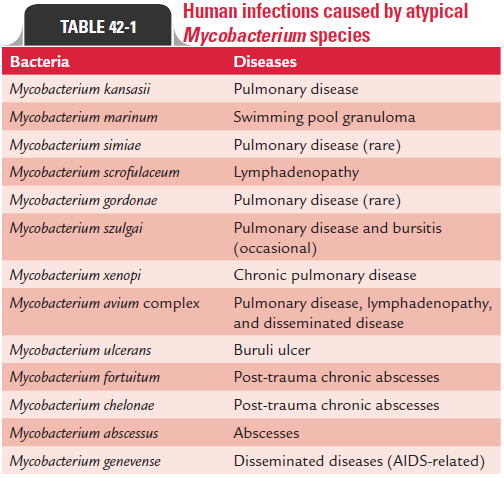Chapter: Microbiology and Immunology: Bacteriology: Nontuberculous Mycobacteria
Nontuberculous Mycobacteria
Nontuberculous Mycobacteria
Introduction
Nontuberculous mycobacteria (NTM) are the mycobacteria other than the tubercle and lepra bacilli. These are also known as mycobacteria other than tubercle bacilli (MOTT). These bacteria, which normally occur as saprophytes of soil and water, may occasionally cause opportunistic infection in humans, which resemble tuberculosis. These bacteria, therefore, were also earlier known as atypical, environmental, or opportunis-tic mycobacteria. The bacteria causing opportunistic infections are summarized in Table 42-1. NTM or atypical mycobacteria show the following features:
1. Some of them are rapid growers. They produce colonies within 1–2 weeks of incubation in Lowenstein-Jensen (LJ ) medium.
2. They can grow at 25°C, 37°C, and even at 44°C.
3. Some of them may produce bright yellow or orange pigments during their growth on the LJ medium.
4. They are acid fast as well as alcohol fast. They may differ from or may resemble the tubercle bacilli.
5. They are arylsulfatase test positive, but are niacin and neutral red reactions negative.

6. They are usually resistant to antitubercular drugs, such as streptomycin, isoniazid (INH), and p-aminosalicylic acid.
7. They are nonpathogenic for guinea pigs, but pathogenic for mouse.
MOTT are classified as rapid growers and slow growers:
· Mycobacterium fortuitum, Mycobacterium chelonae, and Myco-bacterium abscessus are the examples of more rapidly growingMycobacterium species, which require incubation for 3 daysor more for development of the colonies.
· Mycobacterium avium-intracellulare complex and Mycobacte-rium kansasii are the slow-growing Mycobacterium species andrequire 3–8 weeks of incubation for their growth.
Most of the human infections are caused by Mycobacteriumtuberculosis and Mycobacterium leprae. M. avium complex, M. kan-sasii,M. abscessus, M. chelonae, and M. fortuitum are the examplesof MOTT associated with frequent human infections.
Classification
Saprophytic bacteria or MOTT were classified by Runyon into four groups on the basis of their rate of growth and their ability to produce pigments in the presence or absence of light:
1. Runyon’s group I:Pigment-producing mycobacteria areclassified into Runyon’s group I (photochromogenic myco-bacteria), which produce pigment on exposure to light.
2. Runyon’s group II:Runyon’s group II (scotochromogenicmycobacteria), which produce pigments in the dark and in the light.
3. Runyon’s group III:Slow-growing nonpigmented mycobac-teria are classified as Runyon’s group III.
4. Runyon’s group IV:More rapidly growing mycobacteria areclassified as Runyon’s group IV (rapid growers).
This system of classification is known as Runyon’s classification.
Related Topics